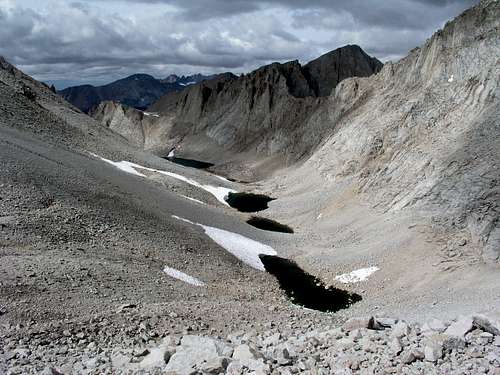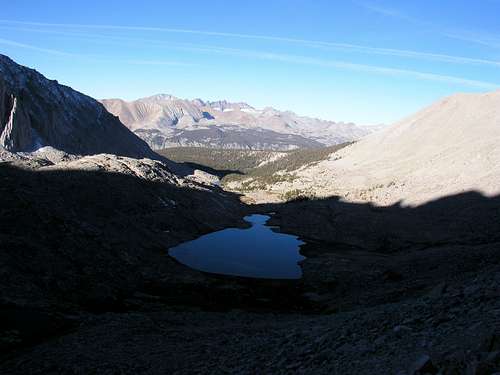|
|
Route |
|---|---|
|
|
36.57860°N / 118.293°W |
|
|
Trad Climbing |
|
|
One to two days |
|
|
5.9 (YDS) |
|
|
20 |
|
|
IV |
|
|
Lost...
 Our route is on the skyline of the picture, which was taken from the South, looking at the crest of the West Face.
Our route is on the skyline of the picture, which was taken from the South, looking at the crest of the West Face.Here's Doug Robinson's writeup of this new route for the 2007 Edition of the American Alpine Journal:
"...Lost", (IV, 5.9+, 20 pitches), SW face, Mt. Whitney
First Ascent Doug Robinson, Michael Thomas, Oct. 3-4, 2006
Our climb was spectacular and, compared to our expectations, epic. Not
counting 8000 vertical of carrying loads in the first 24 hours. Not
counting snowed off the Fishook Arete, our training climb. Not counting
our tarp shelter ripping in half in the middle of the night, exposing
us to a 4" dump of snowfall at 12,000 feet. And not to mention
venturing the first moves onto the entire SW quadrant of a fairly
popular peak. No, the real epic didn't even start until we roped up at
8 a.m, taking a middle arete among many choices. We re-climbed the 9
pitches we had done before dark two years ago, including two 5.9
sections. Then we tried to weasel around the headwall, but it forced us
back to front and center. Straight up was steep and delicate and likely
5.10. What a relief when protection showed up. Soon after, it got dark.
But the moon was nearly full, sparkling off the white granite in
beautiful and climbable ways. Several hours later, best-guess
routefinding led us into moon shadow and under a nasty-looking block.
Couldn't tell what was holding it up over our heads. In the midst of
delicate climbing around it, my foot slipped and my headlamp popped off
to sail down the gully. Fortunately, that kept us from trying any
longer to climb under that block's eerie tonnage. We found another way.
To make a long story short, after 20 pitches we unroped at 2:30 in the
morning. It was so cold, with a biting wind blowing 30+ mph, that with
all our clothes on and walking uphill we could not stay warm. Summit at
4:00 am; a 3-hour nap in the stone shelter.
So much longer than expected, we called our first ascent "...Lost."
Lost for years on the back side of Whitney. Lost our way several times,
as on the crux headwall and up under the threatening block. Lost a
headlamp. However, "Not all who wander are lost." -- J.R.R. Tolkien.
-- Doug Robinson
Getting There
Part of the reason the entire SW quadrant of Mt. Whitney had not been climbed before is that it requires a long approach. The two most logical approaches are either via the Whitney Trail, then dropping down toward Mt. Hitchcock and Guitar Lake by the John Muir Trail; or via the Mountaineer's Route to Iceberg Lake, then over the Whitney-Russell Col and dropping down to Arctic Lake.For both our attempt in 2004 and our successful climb in 2006, we approached via the Mountaineer's Route, setting up camps in the following locations:
- Just above the Whitney Portal because we arrived at night and wanted to start acclimatizing.
- At Iceberg Lake (2004) or Upper Boyscout Lake (2006)
- Near Arctic Lake.
In 2004, we left for our climb in the morning directly from Arctic Lake, but this resulted in a late start, which contributed to aborting the route at nightfall. It takes about 2 hours to reach the start of the climb from Arctic Lake, and it took us a little longer because we needed to scope out which of the various aretes we wanted to climb.
In 2006, given that we had a miserable night getting snowed on after our tarp ripped off at night, we took an extra day to move camp to a nice spot just below our route. This positioned us well for a quick start in the morning, and undoubtedly contributed to our success.
Route Description
There are several aretes on the West-Southwest face of Mount Whitney, none of which had been climbed before Doug and I climbed "Lost". We chose the most prominent of the aretes, right in line with the axis of Guitar Lake.The route then follows pretty much the arete to the summit plateau. It's long, sustained and beautiful.






